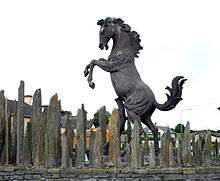Horseleap
| Horseleap Baile Átha an Urchair | |
|---|---|
| Town | |
 Horseleap Location in Ireland | |
| Coordinates: 53°23′34″N 7°34′55″W / 53.392709°N 7.582047°WCoordinates: 53°23′34″N 7°34′55″W / 53.392709°N 7.582047°W | |
| Country | Ireland |
| Province | Leinster |
| County | County Offaly |
| Elevation | 128 m (420 ft) |
| Time zone | WET (UTC+0) |
| • Summer (DST) | IST (WEST) (UTC-1) |
| Irish Grid Reference | N278381 |
Horseleap (Irish: Baile Átha an Urchair) is a town situated upon the Offaly, Westmeath county border in Ireland, along the R446, formerly the main Dublin to Galway road. The village itself possesses a church, primary school, a garden centre, a pub, and a petrol station. Horseleap dates back to the 12th century and is steeped in Uí Néill, Geoghegan history.
History
The village's Irish name (Baile Átha an Urchair or Áth an Urchair) was historically anglicised as Ballanurcher, Athnurcher and Ardnurcher.[1] The name probably derives from the legend that Conchobar mac Nessa was killed here.[2]
According to tradition, the English name - Horseleap - originated in an incident in which a member of the De Lacy family was forced to flee on horseback from the Mac Geoghegans. On approaching his castle and discovering that the drawbridge was raised, he jumped the castle's moat on horseback.[3]
The battle of Ardnocher took place here in 1329 between the forces of Thomas Butler and William Mac Geoghegan. Mac Geoghegan forces won and Butler and many of his soldiers were killed.
Transport
The Midland Great Western Railway once maintained a railway station here. Horseleap railway station opened on 1 December 1876, closed to passenger and goods traffic on 27 January 1947 and finally closed altogether on 1 July 1965.[4]
Horse statue

A story concerning a bronze statue of a prancing horse on the village green claims that it was commissioned in Italy by the sports car manufacturer, Ferrari, and eventually wound up in Horseleap following a series of misadventures. Journalist Joe Saward identified the tale as an urban myth, pointing out that Ferrari have denied the story.[5]
See also
References
- ↑ Placenames Database of Ireland (see archival records)
- ↑ Eugene O'Curry, Lectures on the Manuscript Materials of Ancient Irish History, (Dublin 1861), page 593.
- ↑ Catharina Day, Cadogan Guide Ireland (New Holland Publishers, 2006) page 506.
- ↑ "Horseleap station" (PDF). Railscot - Irish Railways. Retrieved 2007-10-16.
- ↑ The tall tale of a prancing horse Joe Saward's Grand Prix Blog, 4 November 2010.
